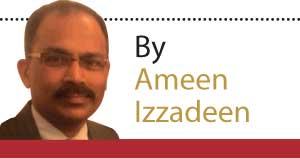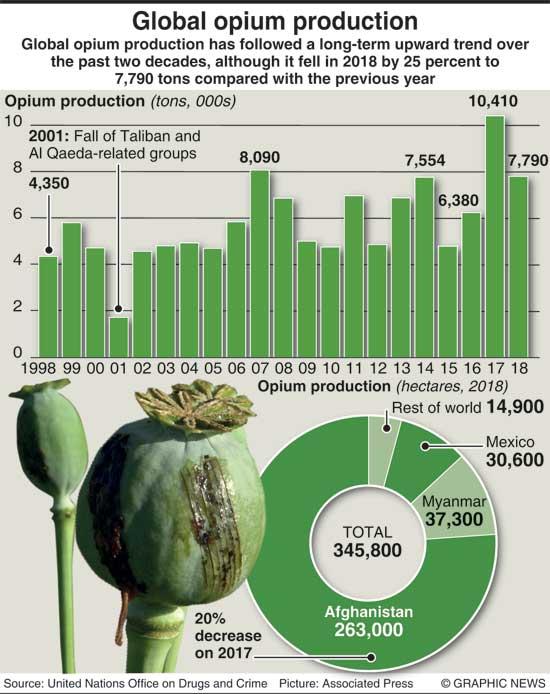Reply To:
Name - Reply Comment
Sri Lanka is being increasingly besieged by illegal drugs and attendant crimes such as terrorism, gun violence, gang warfare, extortion, burglaries, robberies and prostitution. The country’s  youth are falling victim to narcotic drugs while drug lords make billions of rupees, often with political patronage and police protection.
youth are falling victim to narcotic drugs while drug lords make billions of rupees, often with political patronage and police protection.
The recent arrests of scores of officers of the Police Narcotics Bureau, one of the specialized agencies tasked with making the country narcotics-free, only underline the unholy nexus between lawbreakers and law enforcers.
Narcotic drugs pose a serious threat to national security. If unchecked, the drug crisis can lead to a total breakdown in society. Along with crime, more people will become sick, especially in view of the dangerous link between aids and HIV with drug use.
We cannot but welcome the Government’s efforts to weed out the crisis and protect the nation’s youth, whose wellbeing is intricately linked to the nation’s wellbeing and its long-term national interest.
True patriotism is not bigotry or parochial ultra-nationalism. True patriotism is seen in uniting in the resolve to create a country from which blossom right-minded future leaders who will guide the nation’s march towards socio-economic and political development.
According to a report issued by the National Center on Addiction and Substance Abuse (CASA) at Columbia University, drug addiction is linked to learning disabilities and behavioural disorders such as attention-deficit and hyperactivity disorder. More addicts mean more brain-drain from the nation’s pool of intellectuals. If our youth become addicted to narcotics substances, what kind of future leaders will we be producing and what kind of development can we be dreaming of?
In February last year, Sri Lankan lawmaker Ranjan Ramanayake made a startling claim that several parliamentarians were using narcotics substances. He took a blood test to prove he was not one of them but challenged other MPs to do so if they wanted to come clean. The then ruling United National Party appointed a committee headed by House Leader Lakshman Kiriella to probe the charge, but, like many probes in Sri Lanka, this was also
deceptive poppycock.
 Justice Minister Ali Sabry on Wednesday revealed that more than 550,000 Sri Lankans are addicted to narcotic drugs – that is one in every 40 Sri Lankan is a substance addict. He pointed out the number of cases had been on the rise since 2015. The United Nations Office of Drugs and Crimes (UNODC) also says the number of arrests and court cases has been rising in Sri Lanka in recent years. The UNODC identifies Sri Lanka as a key hub in the international narcotics drug trade.
Justice Minister Ali Sabry on Wednesday revealed that more than 550,000 Sri Lankans are addicted to narcotic drugs – that is one in every 40 Sri Lankan is a substance addict. He pointed out the number of cases had been on the rise since 2015. The United Nations Office of Drugs and Crimes (UNODC) also says the number of arrests and court cases has been rising in Sri Lanka in recent years. The UNODC identifies Sri Lanka as a key hub in the international narcotics drug trade.
The bigger picture is much more than meets the eye. The UNODC does not in its annual reports say much about the link between states, especially their secret services, and the international drug mafia.
Former President Maithripala Sirisena has claimed that the terror attacks on Easter Sunday last year were the work of the international drug lords who were infuriated over his crackdown on illicit drug trade, though he has not put forward evidence to substantiate
his assertion.
The use of drugs in international politics and terrorism has a long history. In the English lexicon, the word ‘Assassin’ has its roots in Hashish. In the 11th century Persia, a rebel group took refuge in Alamut, a distant mountainous area. Its members were fed a substance made of Hashish before they were sent on suicide missions to kill political enemies. They came to be known as Hashishin – and ‘assassin’ when Anglicized.
It is believed that even today, terrorists are given narcotics substances before they are sent on suicide missions. It is claimed that ISIS cadres are given captagon, nicknamed “jihad pills” to overcome pain, induce euphoria and remain awake for lengthy battles. It is also an established fact that terror organisations for their upkeep raise funds through the international narcotics trade. The Liberation Tigers of Tamil Eelam (LTTE) used drug money to fund its terrorism in Sri Lanka, say western intelligence reports.
Not only terror groups resort to narcotics trade to achieve their goals. Even states promote the use of drugs in target countries to achieve their foreign policy goals. Take for instance, the Opium Wars of the mid-19th century between China and Britain. The British took control of China’s Shanghai and Guangzhou ports and later Hong Kong by first luring the Chinese people to the opium addiction and then destabilizing the Chinese government.
Russia describes the United States’ presence in Afghanistan as Opium War II.
In 2010, Vladimir Putin, who was then prime minister, told Russian troops that they should be prepared to confront American forces in Afghanistan because Afghanistan’s thriving drug trade supported by the United States and NATO had become the greatest threat to international peace
and security.
Russia is the world’s largest per capita heroin consumer. Much of this stock comes from Afghanistan. According to the UNODC, about 21 percent of the world heroin production (about 70 tons) is consumed by the Russians annually. No organisation, not even the UNODC, knows how much money is involved in the narcotics trade. It could be more than a trillion dollar, with Mexican drug cartels alone making US$ 500 billion a year from the cocaine trade. The US market alone gives them US$ 150 billion. The global heroin trade is said to be in the region of US$ 400 billion a year. About 90 percent of heroin is produced in Afghanistan.
Apart from destabilizing targeted countries, some powerful states’ secret service agencies also involved in the international narcotics trade largely to raise funds for secret operations and to avoid auditory scrutiny and maintain the high level secrecy attached to their clandestine operations. It is alleged that US secret service, the Central Intelligence Agency (CIA), made use of the drug money it earned to help Chiang Kai-Shek’s war against Mao Zedong’s forces in 1949. The CIA’s links with Panama’s then strongman president, Manuel Noriega, a notorious drug operator, and how it got rid of him because he knew a lot are well known. The CIA is said to have turned a blind eye to Noriega’s drug deals because he was sending part of the money to Nicaragua’s pro-US contra rebels. Similarly, Asia’s Golden Triangle was a key asset for the CIA to fund its anti-Communist operations in Asia in the 1970s, it is alleged.
A July 5 datelined report in Russia’s Tass news agency quoted Russia’s Afghan Affairs special presidential envoy Zamir Kabulov as saying, “Those wonderful US intelligence officers, who accuse us of different things, are involved in drug trafficking. Their planes from Kandahar, from Bagram [airfield near Kabul] are flying wherever they want to -- to Germany, to Romania -- without any inspections,” he said. “Every citizen of Kabul will tell you that, everyone is ready to talk about that.”
Governments struggling to eliminate the evil drug monster need to realize that a trillion dollar business cannot thrive without the support of hidden forces with hidden agendas. Beware of them!